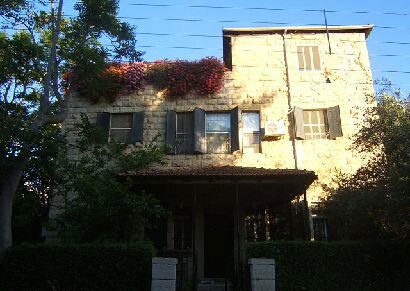Media Watch 14 May 2011

The Jerusalem house where Palestinian writer Ghada Karmi grew up until she and her family were forced to leave it in April 1948. The New York Times bought upper levels built on the property in 1984.
In a report today on the killing of Palestinian teenager Milad Ayyash in eastern occupied Jerusalem today, New York Times bureau chief Ethan Bronner writes:
The dead teenager, Milad Ayyash, was shot in the stomach on Friday during stone-throwing demonstrations in the Jerusalem neighborhood of Silwan and died in the hospital on Saturday. A police spokesman, Micky Rosenfeld, said police officers had not used live fire and were investigating the cause of his death. Witnesses said the gunshot came from inside Beit Yonatan, a Jewish-owned building in Silwan, either from a security guard or a resident. The teenager’s family declined to allow a police autopsy, Mr. Rosenfeld said.
Note how Bronner makes sure to say “stone-throwing” as if to justify the shooting. There’s no evidence that Milad was throwing stones, nor that stone-throwing – a largely symbolic act of protest against brutal and heavily armed Israeli occupation forces – could ever justify live fire. Israeli settlers and religious Jews routinely throw stones at police and are never shot.
Bronner apparently has a habit of this kind of distortion, excuse-making and indeed outright falsification. In the same article Bronner writes:
After Israel declared independence on May 15, 1948, armies from neighboring Arab states attacked the new nation; during the war that followed, hundreds of thousands of Palestinians fled or were driven from their homes by Israeli forces. Hundreds of Palestinian villages were also destroyed. The refugees and their descendants remain a central issue of contention in the Israeli-Palestinian conflict.
This is standard Zionist propaganda that bears little resemblance to the facts. The ethnic cleansing of Palestine by Zionist forces began in late 1947, so that by 15 May 1948, hundreds of thousands of Palestinians had already been expelled from their villages and cities before a single soldier from any Arab army had intervened. The exodus from, for example, Jaffa began in early 1948 after Zionist terrorists belonging to the Stern Gang set off a massive car bomb destroying the Jaffa municipality building on 4 January (this is all well-documented in books by right-wing Israeli historian Benny Morris, among others). Many villages in the north of Palestine were also depopulated around that time.
Ilan Pappe notes in The Ethnic Cleansing of Palestine that between the beginning of December 1947 and the end of March 1948, Zionist forces:
had been able to complete the first stage of the cleansing of Palestine, even before the master plan had been put into effect. If there were a turning point in April, it was the shift from sporadic attacks and counter-attacks on the Palestinian civilian population towards the systematic mega-operation of ethnic cleansing that now followed (p. 85).
The notorious massacre of Palestinian villagers at Deir Yassin occurred on 9 April 1948, and triggered – as intended by its perpetrators – mass terror that led many more Palestinian villagers to flee their homes.
My mother’s village of Lifta, currently in the news because of Israel’s plans to destroy surviving houses, was also depopulated in January 1948 along with dozens of other Jerusalem area villages. In light of the facts, the Arab “invasion” should properly understood as a belated and unsuccessful intervention to save Palestinians from further expulsions.
It is really inexcusable that Bronner does not – or pretends not to – know this since he himself lives on the West Jerusalem property of Nakba survivor and noted Palestinian writer Ghada Karmi. Karmi and her family were among the last to leave the Qatamon neighborhood of Jerusalem toward the end of April 1948, as she recounted in her brilliant memoir In Search of Fatima. But many of the families had already fled after the Zionist bombing of the nearby Semiramis Hotel, which killed 26 civilians including the Spanish consul-general, on the night of 4-5 January 1948.
Thomas Friedman, then New York Times bureau chief, purchased the house in 1984 on behalf of the newspaper, from Israelis who occupied it. This story was exclusively told by The Electronic Intifada last year.
For Bronner to continue to promote the Israeli propaganda that the expulsion and flight of Palestinians – the Nakba – occurred only after 15 May 1948 when the much exaggerated Arab “invasion” occurred, is not merely making excuses for Israel’s crimes. It is nothing short of Nakba denial.





Comments
Arab armies 'attacked the new nation'
Permalink Frank Barat replied on
This is also a complete falsification of history as the Arab armies never entered the territories that the UN had given (contrary to International Law) Israel. The Arab armies, defended the territories that the UN partition plan had given to the Palestinians. They therefore never 'attacked the new nation'.